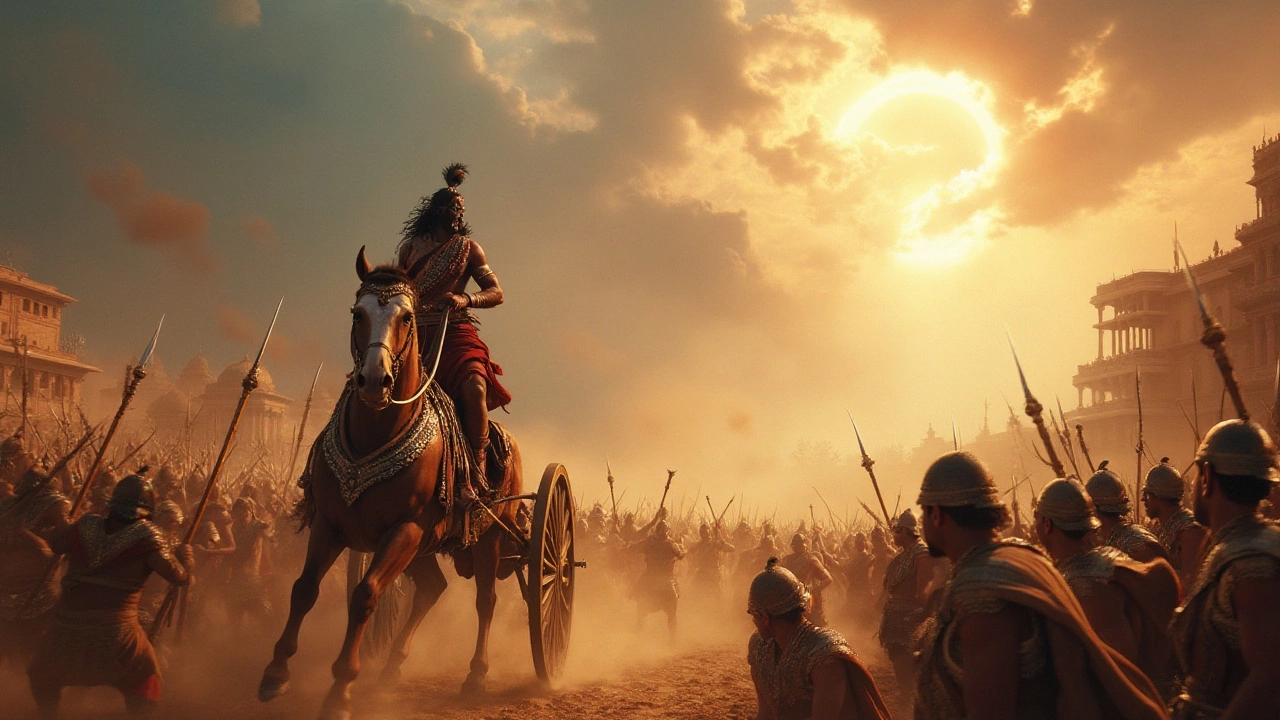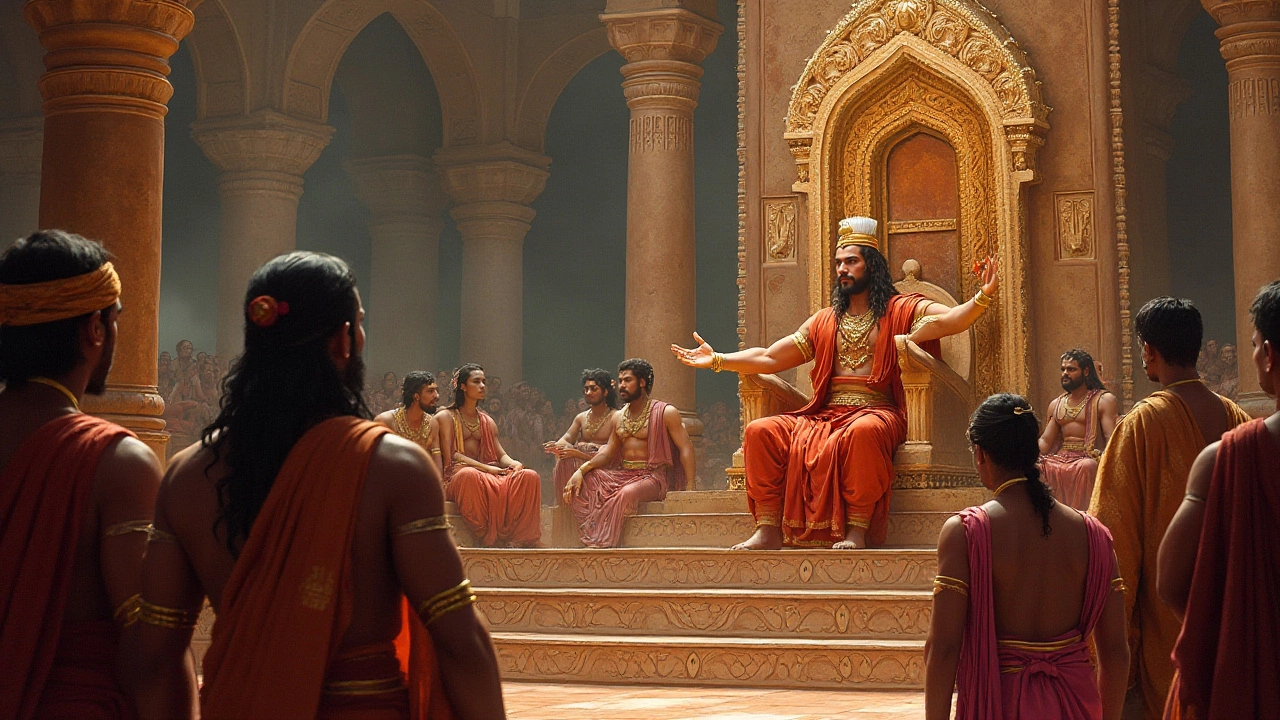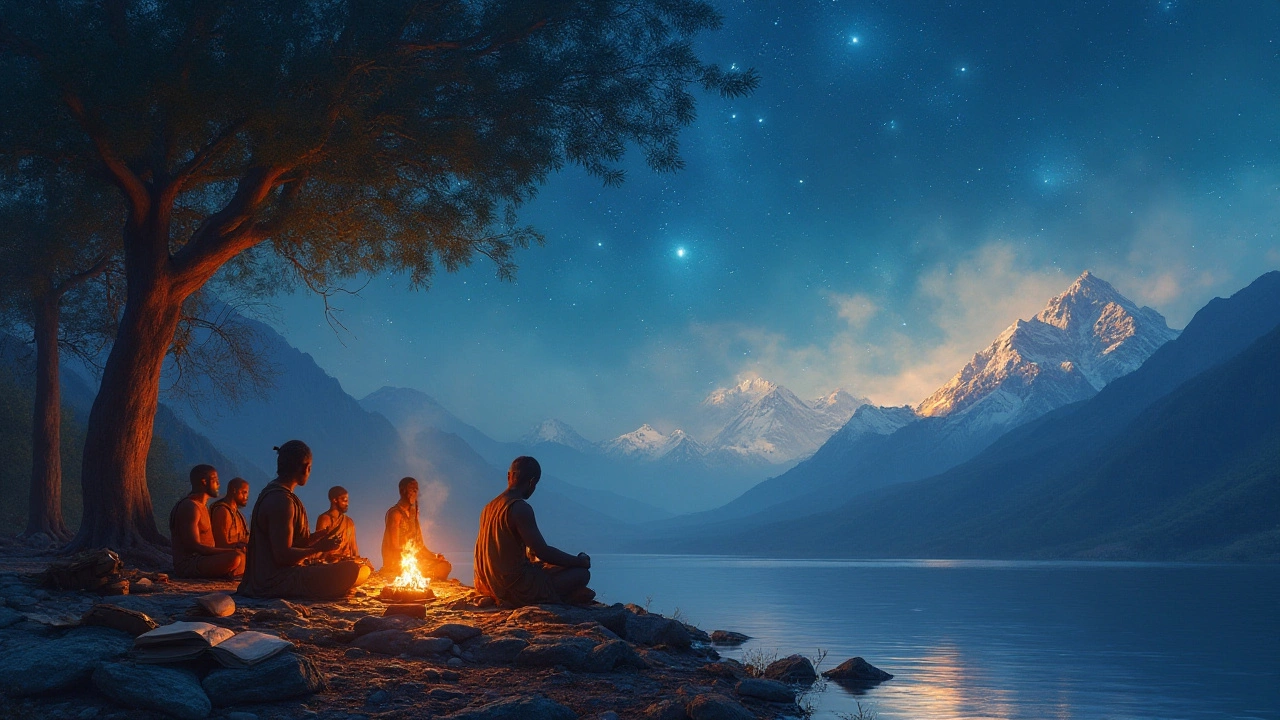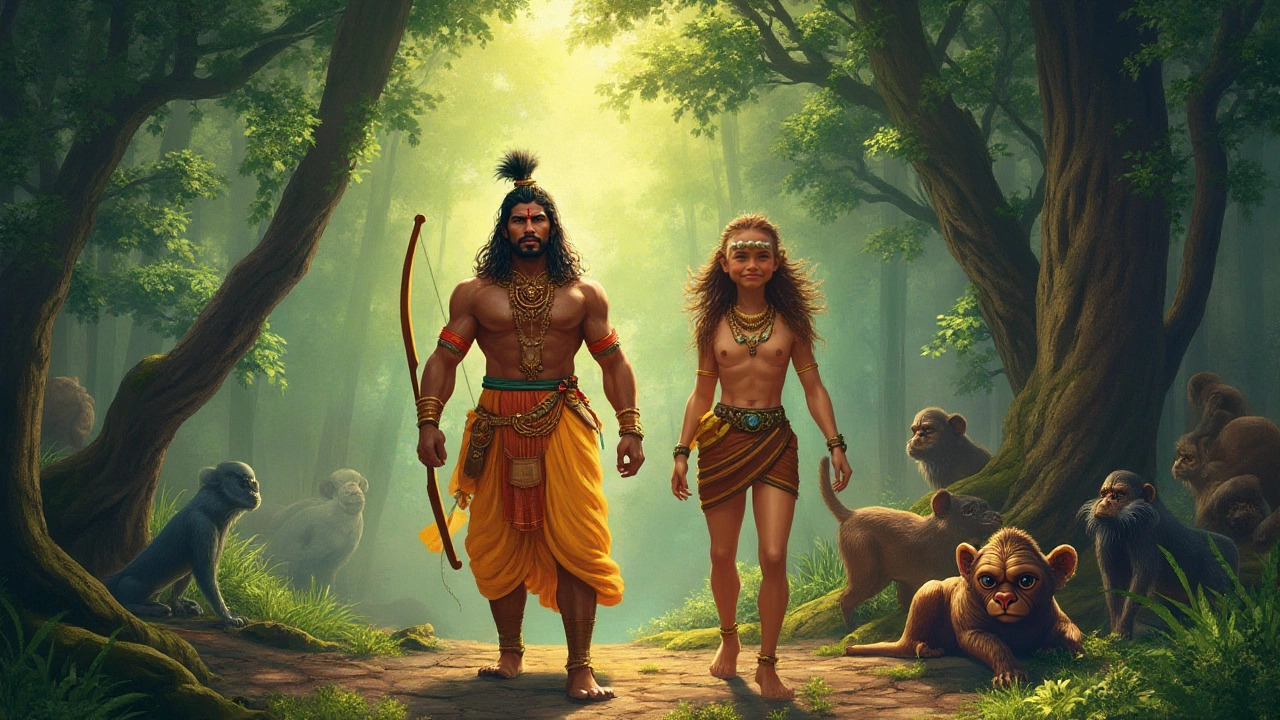Amid the vast expanse of Indian literature, two epic poems stand out, their stories echoing through the corridors of time. The Ramayana and the Mahabharata, more than just ancient texts, are the cultural fabric that has influenced generations of thinkers, artists, and philosophers. Each serves as a testament to human nature, exploring themes of duty, honor, and morality while weaving intricate tales of gods, kings, and warriors.
Created centuries ago, these epics are more than historical artifacts; they are living traditions that continue to shape cultural identities and social norms. The adventures and moral dilemmas of Rama in the Ramayana, alongside the vast and complex narrative of the Mahabharata, offer a fascinating window into the rich tapestry of Ancient Indian life.
The Ramayana narrates the life of Prince Rama, an incarnation of the divine, who embarks on an epic quest to rescue his beloved wife, Sita, from the clutches of the demon king Ravana. Meanwhile, the Mahabharata, with its myriad characters and interwoven subplots, encapsulates the great war of Kurukshetra and delves into the philosophical teachings of the Bhagavad Gita.
- Origins and Significance
- Storylines and Themes
- Cultural Impact and Influence
- Relevance in Modern Times
Origins and Significance
The Ramayana and the Mahabharata, two monumental pillars of Indian cultural heritage, trace their origins back to the ancient Sanskrit literature of India. The Ramayana, attributed to the sage Valmiki, is believed to have been composed in the 5th to 4th century BCE, making it one of the early works of Indian epic poetry. Meanwhile, the Mahabharata, traditionally credited to the sage Vyasa, was likely developed between the 8th to 9th centuries BCE through to the 4th century CE, as scholars see it as a compilation that took shape over hundreds of years. Together, these epic poems form the Itihasa, meaning 'history' in Sanskrit, which not only narrates the larger-than-life adventures and conflicts of their protagonists but also encapsulates spiritual and philosophical teachings that continue to inspire millions.
The significance of these works lies not only in their antiquity but also in their profound impact on Indian culture, religion, and ethics. Often regarded as the eternal sources of wisdom, the tales have transcended time and geography to become inseparable parts of the spiritual landscape of India. The Ramayana, through its portrayal of Rama's idealistic journey, sets forth the principles of Dharma or righteous living. Within it, the narration delves into complex ethical dilemmas and the victory of good over evil. The Mahabharata intricately weaves a narrative of familial conflict and cosmic dilemmas through its epic battle of Kurukshetra, and it is esteemed for housing the famous Bhagavad Gita, where deep philosophical dialogues are staged between Lord Krishna and the warrior Arjuna. These instances highlight the epics' incredible ability to convey ideological depth within compelling storytelling.
"The Mahabharata is not just a story, it is a still-felt presence, a cloud that moves with you through the ages," writes Indian scholar Devdutt Pattanaik, illustrating its timeless relevance.
Beyond their storytelling prowess, these epics are revered for their contributions to the evolution of Indian literary forms, language, and performing arts. Ancient versions of these stories were originally passed down orally, forming the cornerstone of traditional education and oral history in India. Their narratives have been reiterated across generations through diverse mediums like plays, shadow puppetry, and classical dance forms, enriching their lore with each retelling. They provide a reflection, however mythologically adorned, of the societal values and historical contexts they emerged from. What is perhaps most striking is how the epics have maintained their relevance, with adaptations and interpretations continuing to flourish, thereby fueling conversations around the timeless themes they address, forever intertwining with India's collective consciousness.

Storylines and Themes
The Ramayana and the Mahabharata offer more than just epic battles and divine interventions; they delve deep into human experiences, motivations, and the moral dilemmas faced by their characters. The storyline of the Ramayana follows the life of Rama, whose steadfast virtues and resilience are tested through arduous trials. Rama's journey begins in the idyllic city of Ayodhya, where he is a beloved prince destined for the throne. However, fate has different plans, culminating in his exile to the forest for fourteen years—an exile instigated by his stepmother Kaikeyi's cunning wish for her own son to ascend the throne.
Rama's unwavering sense of duty and loyalty guides him through the wilderness, accompanied by his devoted wife Sita and his loyal brother Laxman. An integral part of the epic is the abduction of Sita by the demon king Ravana, which sets the stage for Rama's quest to rescue her. This journey is a microcosm of the human pursuit of righteousness amidst chaos. It challenges the protagonist's moral compass and sheds light on his strength and courage, which inspire many across generations.
In contrast, the Mahabharata presents a sprawling canvas featuring a complex array of characters and intricate narratives. At its heart is the epic Kurukshetra War, a culmination of familial discord, ambitions, and betrayal. The battle draws from a centuries-old family feud between the Pandavas and the Kauravas, two branches of the Kuru dynasty. The Pandavas, led by Yudhishthira, embody justice and virtue, while the power-hungry Kauravas, led by Duryodhana, represent vice and ambition.
One of the central themes of the Mahabharata is the exploration of dharma, or duty, sprinkled with moments of personal introspection and divine insight. This is beautifully encapsulated in the Bhagavad Gita, a revered dialogue between Prince Arjuna and Lord Krishna on the battlefield. As Arjuna hesitates to fight against his kinsmen, Krishna imparts profound wisdom on duty, righteousness, and the eternal self. These teachings have resonated over time and remain a source of spiritual guidance worldwide.
The narratives of the Ramayana and the Mahabharata are imbued with timeless themes that continue to resonate with modern audiences, such as the fight between good and evil, loyalty, sacrifice, and destiny. Through the journeys of their protagonists, these Indian epics offer profound reflections on the human condition, illustrating that the struggles faced by its characters are as relevant today as they were millennia ago.
The Indian scholar A. K. Ramanujan observed, "In India, there is a story for every moral, and whenever there’s a moral, there’s always a story"—a testament to the intertwining of life lessons and narratives found in these epic tales.

Cultural Impact and Influence
The profound influence of the Indian epics, the Ramayana and the Mahabharata, on the cultural and social fabric of India is undeniable. These ancient narratives have transcended literature to become integral elements of the country's religious, artistic, and social traditions. From the vibrant festivals that bring communities together to the traditional dances that recount the heroic exploits of their characters, these epics live and breathe through cultural expressions across the Indian subcontinent.
One notable aspect of their influence is found in the realm of classical dance and drama. For instance, Kathakali, a classical dance form of Kerala, vividly portrays stories from both the Ramayana and the Mahabharata. Through intricate gestures, dramatic makeup, and detailed costumes, performers bring these age-old stories to life, mesmerizing audiences with their artistry and storytelling prowess. Similarly, epic recitations during the festival of Ramlila, commemorating the life of Lord Rama, showcase the enduring relevance of the Ramayana in contemporary lives.
Art forms aren't the only arenas where these texts exert their influence. They have also significantly shaped the ethical and philosophical paradigms of Indian and Southeast Asian societies. The Bhagavad Gita, part of the Mahabharata, offers insights into duty, righteousness, and the moral dilemmas faced by individuals. Its teachings have inspired leaders across the world, including Mahatma Gandhi, who once said,
"The Gita is not only my Bible, my Koran; it is more than that - it is my mother."This underscores how the philosophical concepts embedded in these epics transcend time and geography.
In literature and language, these epics have left an indelible mark. They have enriched numerous regional languages and inspired countless poets and authors to reinterpret these narratives for new generations. Whether it’s R. K. Narayan’s concise retelling of the Ramayana or Peter Brook's stage adaptation of the Mahabharata, each endeavor breathes new life into these ancient tales, ensuring their relevance and accessibility to global audiences.
The social structures and values promoted by the Ramayana and Mahabharata continue to echo in Indian society today. The idea of Dharma, or duty, as exemplified by characters like Rama, reinforces notions of loyalty, sacrifice, and responsibility that are integral to Indian familial and social relationships. This is mirrored in daily interactions, where people often draw parallels between personal experiences and these epic narratives.
As we delve into the world of Indian cinema, it’s clear these epics have influenced filmmaking and storytelling significantly. Multiple adaptations and inspired works draw from their timeless tales, demonstrating the epics’ continuous appeal and adaptability. Notably, S. S. Rajamouli’s

Relevance in Modern Times
In the bustling world of 2025, the Ramayana and Mahabharata remain incredibly influential, captivating audiences in myriad ways. These timeless epics are no longer confined to the manuscripts of libraries but have permeated every layer of society, from modern literature and theater to cinema and digital media. The **Ramayana** and **Mahabharata** are more than stories; they serve as ethical and moral guides, teaching us valuable lessons about duty, righteousness, and the importance of living a life of integrity.
Contemporary adaptations in movies and television have breathed new life into these ancient tales, ensuring they resonate with younger generations. The enduring appeal of these epics lies in their universal themes. They're not just narratives from a bygone era—they reflect the problems and predicaments that modern individuals face daily, making them relatable even today. From the portrayal of family dynamics to the complexities of political power, the epics mirror the society we live in.
The Mahabharata, with its complex characters and intricate plots, provides deep philosophical insights—none more profound than those in the Bhagavad Gita. Its dialogue between Lord Krishna and Arjuna continues to be a subject of study in philosophy and management courses worldwide, underscoring the importance of moral duty and leadership. According to a survey published in 'Indian Literature Today', 60% of Indian youths find the teachings of these epics relevant to making ethical decisions.
The realm of digital technology has also allowed these stories to reach a global audience. Interactive apps, games, and graphic novels offer fresh engagement with the fantastic world of Indian epic heroes. Educational programs often use these stories to impart historical contexts, helping students grapple with critical thinking by analyzing the actions and decisions of the characters.
Even in politics and social movements, references to characters and scenarios from the epics are frequent. Leaders and orators draw parallels to convey messages of righteousness and justice, invoking these stories' rich symbolism and moral grounding. Thus, the epics serve both as a cultural anchor and a model of virtuous behavior, reminding us of the timeless human quest for meaning and truth.
"The Mahabharata and Ramayana are not just stories but are deeply embedded in the cultural psyche of India. Their narratives continue to impart significant life lessons and societal values," emphasizes Dr. Kavita Sharma, a renowned historian and author on Indian literature.
The enduring charm of the Ramayana and Mahabharata lies in their ability to evolve with time while preserving their originality. They guide millions across different walks of life, proving that ancient wisdom holds great power and relevance even in our rapidly changing world.
